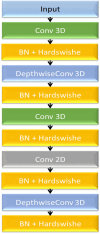Histopathological-based brain tumor grading using 2D-3D multi-modal CNN-transformer combined with stacking classifiers
- PMID: 40739310
- PMCID: PMC12311013
- DOI: 10.1038/s41598-025-11754-9
Histopathological-based brain tumor grading using 2D-3D multi-modal CNN-transformer combined with stacking classifiers
Abstract
Reliability in diagnosing and treating brain tumors depends on the accurate grading of histopathological images. However, limited scalability, adaptability, and interpretability challenge current methods for frequently grading brain tumors to accurately capture complex spatial relationships in histopathological images. This highlights the need for new approaches to overcome these shortcomings. This paper proposes a comprehensive hybrid learning architecture for brain tumor grading. Our pipeline uses complementary feature extraction techniques to capture domain-specific knowledge related to brain tumor morphology, such as texture and intensity patterns. An efficient method of learning hierarchical patterns within the tissue is the 2D-3D hybrid convolution neural network (CNN), which extracts contextual and spatial features. A vision transformer (ViT) additionally learns global relationships between image regions by concentrating on high-level semantic representations from image patches. Finally, a stacking ensemble machine learning classifier is fed concatenated features, allowing it to take advantage of the individual model's strengths and possibly enhance generalization. Our model's performance is evaluated using two publicly accessible datasets: TCGA and DeepHisto. Extensive experiments with ablation studies and cross-dataset evaluation validate the model's effectiveness, demonstrating significant gains in accuracy, precision, and specificity using cross-validation scenarios. In total, our brain tumor grading model outperforms existing methods, achieving an average accuracy, precision, and specificity of 97.1%, 97.1%, and 97.0%, respectively, on the TCGA dataset, and 95%, 94%, and 95% on DeepHisto dataset. Reported results demonstrate how the suggested architecture, which blends deep learning (DL) with domain expertise, can achieve reliable and accurate brain tumor grading.
Keywords: 2D-3D convolutional neural network; Brain tumor grading; Histopathological image analysis; Hybrid deep learning architecture; Stacking classifiers; Vision transformer.
© 2025. The Author(s).
Conflict of interest statement
Declarations. Competing interests: The authors declare no competing interests.
Figures








Similar articles
-
SG-Fusion: A swin-transformer and graph convolution-based multi-modal deep neural network for glioma prognosis.Artif Intell Med. 2024 Nov;157:102972. doi: 10.1016/j.artmed.2024.102972. Epub 2024 Aug 31. Artif Intell Med. 2024. PMID: 39232270
-
A deep learning approach to direct immunofluorescence pattern recognition in autoimmune bullous diseases.Br J Dermatol. 2024 Jul 16;191(2):261-266. doi: 10.1093/bjd/ljae142. Br J Dermatol. 2024. PMID: 38581445
-
Development and Validation of a Convolutional Neural Network Model to Predict a Pathologic Fracture in the Proximal Femur Using Abdomen and Pelvis CT Images of Patients With Advanced Cancer.Clin Orthop Relat Res. 2023 Nov 1;481(11):2247-2256. doi: 10.1097/CORR.0000000000002771. Epub 2023 Aug 23. Clin Orthop Relat Res. 2023. PMID: 37615504 Free PMC article.
-
Advancing respiratory disease diagnosis: A deep learning and vision transformer-based approach with a novel X-ray dataset.Comput Biol Med. 2025 Aug;194:110501. doi: 10.1016/j.compbiomed.2025.110501. Epub 2025 Jun 9. Comput Biol Med. 2025. PMID: 40494170
-
Transformers for Neuroimage Segmentation: Scoping Review.J Med Internet Res. 2025 Jan 29;27:e57723. doi: 10.2196/57723. J Med Internet Res. 2025. PMID: 39879621 Free PMC article.
References
-
- Gritsch, S., Batchelor, T. T. & Gonzalez Castro, L. N. Diagnostic, therapeutic, and prognostic implications of the 2021 world health organization classification of tumors of the central nervous system. Cancer128(1), 47–58 (2022). - PubMed
-
- Abd-Ellah, M. K., Awad, A. I., Khalaf, A. A. & Hamed, H. F. A review on brain tumor diagnosis from MRI images: Practical implications, key achievements, and lessons learned. Magn. Resonance Imaging61, 300–318 (2019). - PubMed
-
- Komori, T. Grading of adult diffuse gliomas according to the 2021 WHO classification of tumors of the central nervous system. Lab. Investig.102(2), 126–133 (2022). - PubMed
-
- Pei, L., Vidyaratne, L., Hsu, W.-W., Rahman, M.M., Iftekharuddin, K.M. Brain tumor classification using 3d convolutional neural network. In: Brainlesion: Glioma, Multiple Sclerosis, Stroke and Traumatic Brain Injuries: 5th International Workshop, BrainLes 2019, Held in Conjunction with MICCAI 2019, Shenzhen, China, October 17, 2019, Revised Selected Papers, Part II 5, pp. 335–342 (Springer, 2020).
MeSH terms
LinkOut - more resources
Full Text Sources
Medical

